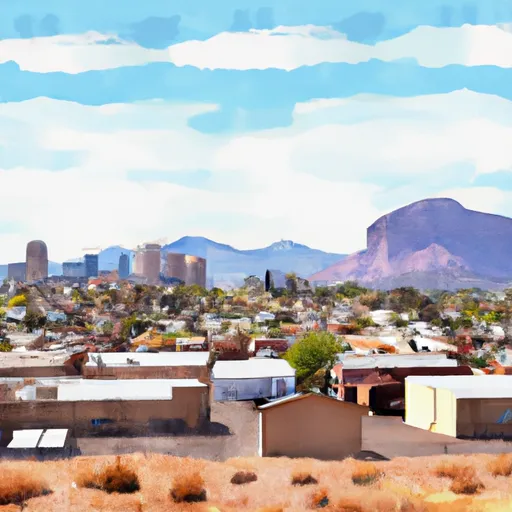-
 Snoflo Premium
Snoflo Premium
Get unlimited access to all our content
With no Ad interruptions! - Start Your Free Trial Login with existing account
Kirkland
Eden Index
Climate
9.3
•
Recreation
5.4
•
Community
•
Safeguard
5.6/10

Kirkland, Arizona is a small rural community located in Yavapai County. It experiences a semi-arid climate, characterized by hot summers and mild winters. Summers are typically dry with temperatures often exceeding 90°F (32°C), while winters are relatively mild with temperatures ranging from 40°F to 60°F (4°C to 15°C). The region receives an average annual rainfall of about 13 inches, mostly occurring during the summer monsoon season.
Hydrologically, Kirkland is situated in a region with a complex network of rivers, creeks, and underground aquifers. The nearby Kirkland Valley and Kirkland Creek serve as important hydrological constituents, providing water for irrigation and supporting the local ecosystem.
Kirkland offers various outdoor recreation opportunities for nature enthusiasts. The nearby Prescott National Forest offers ample opportunities for hiking, camping, and wildlife viewing. The area's diverse topography also makes it a great destination for off-roading, with numerous trails available to explore. Nearby lakes and rivers, such as Lynx Lake and the Verde River, provide opportunities for fishing, boating, and kayaking. With its scenic landscapes and outdoor activities, Kirkland provides a charming escape for those seeking nature and adventure.
What is the Eden Index?
The Snoflo Eden Index serves as a comprehensive rating system for regions, evaluating their desirability through a holistic assessment of climate health, outdoor recreation opportunities, and natural disaster risk, acknowledging the profound impact of these factors on livability and well-being.
Climate Health Indicator (CHI): 9.3
Kirkland receives approximately
496mm of rain per year,
with humidity levels near 46%
and air temperatures averaging around
15°C.
Kirkland has a plant hardyness factor of
8, meaning
plants and agriculture in this region tend to thrive here all year round.
By considering the ideal temperature range, reliable water supplies, clean air, and stable seasonal rain or snowpacks, the Climate Health Indicator (CHI) underscores the significance of a healthy climate as the foundation for quality living.
A healthy climate is paramount for ensuring a high quality of life and livability in a region, fostering both physical well-being and environmental harmony. This can be characterized by ideal temperatures, reliable access to water supplies, clean air, and consistent seasonal rain or snowpacks.
Weather Forecast
Streamflow Conditions
Bill Williams
Area Rivers
Bill Williams
Snowpack Depths
Bill Williams
Reservoir Storage Capacity
Bill Williams
Groundwater Levels
Recreational Opportunity Index (ROI): 5.4
The Recreational Opportunity Index (ROI) recognizes the value of outdoor recreational options, such as parks, hiking trails, camping sites, and fishing spots, while acknowledging that climate plays a pivotal role in ensuring the comfort and consistency of these experiences.
Access to outdoor recreational opportunities, encompassing activities such as parks, hiking, camping, and fishing, is crucial for overall well-being, and the climate plays a pivotal role in enabling and enhancing these experiences, ensuring that individuals can engage in nature-based activities comfortably and consistently.
Camping Areas
| Campground | Campsites | Reservations | Toilets | Showers | Elevation |
|---|---|---|---|---|---|
| Yavapai | 21 | 5,641 ft | |||
| Constellation Park | 30 | 2,223 ft | |||
| Lower Wolf Creek | 20 | 6,009 ft | |||
| Alto Pit | 10 | 6,084 ft | |||
| White Spar | 59 | 5,639 ft | |||
| Vulture Peak Rd - Box Wash dispersed | None | 2,541 ft | |||
| Watson Lake Park | None | 5,199 ft |
Nearby Fishing
Nearby Ski Areas
Catastrophe Safeguard Index (CSI):
The Catastrophe Safeguard Index (CSI) recognizes that natural disaster risk, encompassing floods, fires, hurricanes, and tornadoes, can drastically affect safety and the overall appeal of an area.
The level of natural disaster risk in a region significantly affects safety and the overall livability, with climate change amplifying these risks by potentially increasing the frequency and intensity of events like floods, fires, hurricanes, and tornadoes, thereby posing substantial challenges to community resilience and well-being.
Community Resilience Indicator (CRI):
The Community Resilience Indicator (CRI) recognizes that education, healthcare, and socioeconomics are crucial to the well-being of a region. The CRI acknowledges the profound impact of these elements on residents' overall quality of life. By evaluating educational resources, healthcare accessibility, and economic inclusivity, the index captures the essential aspects that contribute to a thriving community, fostering resident satisfaction, equity, and social cohesion.

